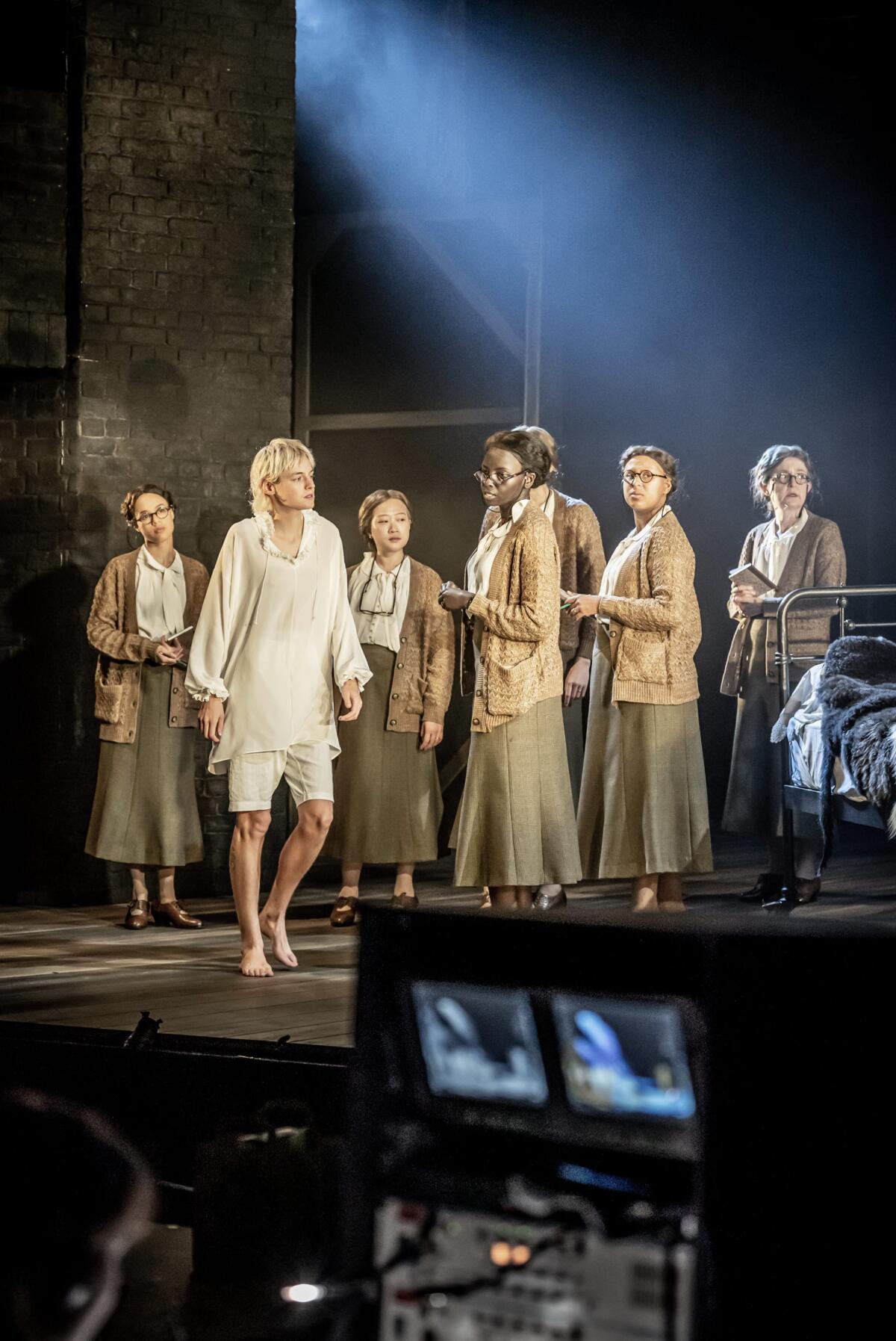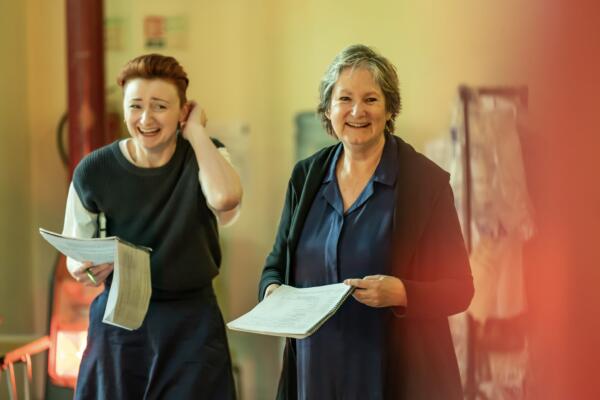Orlando | Rehearsal Diary
Orlando– Week Six
Monday 21st November 2022
Now we enter what we call ‘Tech Week’. We have two more days in the rehearsal room before we head to the theatre on Wednesday and we’re using the time to get as many runthroughs in as possible.
This morning, after addressing a few notes, we did a run for the dressers who will be working on the show, plus some colleagues from the MGC office. Neil Bartlett was watching again too. The run went cleanly but was a little under-energised. This possibly isn’t a bad thing, as the actors need to reserve their energy for a busy week of late nights at the theatre. Michael’s big note, though, was for the company to retain in their muscle-memory the show as a whole as we won’t be running it again until Friday, when we’ll do a dress run and then we’ll be in front of an audience on Saturday.
Michael gave some notes and said that we would do one more runthrough tomorrow morning before the rehearsal room is cleared of props and costume and everything is moved to the theatre. The afternoon was given over to the Costume Department, who worked through all the quick changes that happen off-stage so that when we work through them in the tech on Wednesday we hopefully won’t have to stop.
Tuesday 22nd November 2022
Our last day in the rehearsal room. It’s always strange saying goodbye to a space you’ve become used to over five or more weeks, but we feel very ready to move to the theatre. We spent our last day, until lunch, doing a final runthrough. We were working with minimal costume, as a lot of them have already moved to the theatre, but even getting to run with Emma’s costume changes was useful.
There wasn’t a lot to work on after the runthrough so we just did some talking notes. I was given the last hour or so to get to the end of the play with the understudies, which was incredibly useful. It’s a relief to know we’re heading into tech with all of them having covered everything in the rehearsal room.
Wednesday 23rd November 2022
Today we stepped into the theatre for the first time! It’s always an exciting time to see all of the design elements come together, plus the place we’ll be calling home for the coming weeks and months. It can be nerve-wracking too, but I think because we’ve had such a focused and rigorous rehearsal process we feel ready to put the next coat of paint on our production.

I arrived at the theatre at 10am to walk about the stage to help with lighting. Since we only have four tech sessions – around twelve hours in total – to technically rehearse our eighty-minute show, Lighting Designer Howard Hudson and Michael have been making the most of the time when the actors aren’t called to get ahead with ‘plotting’ the lights – this means getting a basic draft down of what each scene might look like. Howard and Composer Alex Baranowski have been in the theatre since Monday fitting-up their lights and speakers and testing everything. They will both have done some basic plotting. This morning is the first real chance for them to make this more specific with bodies on stage, walking around, for them to light before the actors arrive.

The actors aren’t called until later in the day and start with a ‘Health and Safety’ talk from the venue and our own Stage Management Team, before launching into a vocal exploration of the space with our Dialect Coach, Richard Ryder. He runs a warm-up on stage with the whole cast, then gets them to stand all over the auditorium and stage delivering lines to each other to see what it feels like to project to seven hundred-plus seats. Some productions have head mics for their actors, which is increasingly becoming the norm in West End theatres as sound design and soundscapes become more prominent. We’ve decided to opt for some on-stage mics, which are placed at the front of the stage, and a couple of hidden mics around the stage to provide some support to voices over the sound design. Emma, who competes with most of the soundscapes, has a head mic throughout. The cast is reminded that this doesn’t mean they no longer have to project – it will simply provide them with support. The actors have also been shown how to put their hair up properly so that wigs can be put on quickly and simply before they get on stage. This requires them to pin their hair and put a cap on, which they’ll keep on anytime they are called for technical rehearsals.

After a dinner break, we start in full costume and wigs. This is always my favourite part, seeing everyone in costume, and this production was no exception. It was quite extraordinary seeing nine Virginia Woolfs appear on stage!

We worked out that we’d need to get through about eighteen pages of text per session, which is around twenty minutes of the show. For anyone who has run a tech before, they’ll know this is ambitious as the first session is often about getting the opening five minutes of the show looking and sounding correct. As we had our Sound Designer working in the room throughout rehearsals and many videos were sent to our Lighting Designer during the rehearsal period, the opening was a breeze and we stuck to schedule, which was quite amazing. The actors finished at 9.45pm and got out of costume and wigs, ready to leave at 10pm. In those last fifteen minutes the Technical Team gathered to discuss progress and what needed to be achieved the following day.
Thursday 24th November 2022
10am the next day and I’m back in the theatre, standing on stage for lighting so that we can get lots of the scenes ‘dry teched’ before the actors arrive for an afternoon session. ‘Dry teching’ means doing everything with lights and sound without the actors, so that we can test how things work before they get here.

2pm and we started the tech with the actors picking up where we left off yesterday, just before quite a complicated technical moment where tables are brought on stage from the wings. The space is tight and when we did it in the rehearsal room we weren’t battling with a raked stage, so everything moved more smoothly. A ‘rake’ is when the stage has a slight gradient to it, so that the back of the stage is higher than the front. This is to help with sight-lines so that people sitting on the back row of the auditorium still get a good view of the stage. Most West End theatres have them and the one at The Garrick is very slight. This sort of thing is impossible to dry tech without the actors as it needs all of the people on stage to do it, and until we get into the theatre we can’t really know how the rake will affect us.

Another area we needed to rehearse carefully due to the rake is when Millie Wong skates on roller blades, as the rake means she is going slightly downhill at points so we have to be careful she can brake and not go off the end of the stage. Another element that can add to this potential hazard is the haze, which we have added to this scene to create a magical icy atmosphere.

The call continued into the evening and though we were maybe a few pages behind where I predicted we might need to be, I think we will still be able to cover all of the necessary material in the final tech session tomorrow and do a dress run in the evening.
Friday 25th November 2022
Another morning of getting ahead with some dry teching before the actors arrived in the afternoon. We managed to get to the end of the play and had a dress run in the evening as planned.

Incredibly, it goes very smoothly technically and we didn’t need to stop the dress for any reason. Everyone made their costume changes and no one bumped into any furniture! After the dress we still had an hour where we could work some little bits with Ben Wright, which was useful and we felt that the following afternoon we’d be able to sit down for more in-depth notes.
Saturday 26th November 2022
The day of the first preview! We started with notes in the Green Room, the main one being that though the show was technically clean, the play had lost some of the front-footed energy it requires to keep an audience engaged and maintain the flow of the story. We’d discussed the night before whether we should do notes on stage in the afternoon or, because the show is only eighty minutes long, just go for another run. We decided doing a second dress run before the first preview would be most beneficial instead of looking at little bits, which might be more confusing, and the main note was about confidence and flow in the space anyway.

The second dress run was leaps and bounds better. Everyone was really listening and being in the moment, rather than worrying about what happens next. Vocally it was clearer and, though we could see things that we’d like to work on during previews, it felt like the technical elements and story were holding together. We had some last-minute ideas about the ending, which we worked in after the dress run, and then sorted out the curtain-call, when the actors take their bow.

Before the preview, the actors did an onstage warm-up together and Michael shared a few notes, but mostly it was about resting and focusing. It’s exciting bringing a show to an audience for the first time as we learn so much about when an audience leans into it and wants more, and when we might lose them, and then we can diagnose why and try to rectify it.

During the previews, of which we have eight, we will continue to work during the afternoons on sections and notes that Michael feels needs attention, either for technical or acting reasons, and then at a certain time the show will be ‘frozen’, which means we won’t change anything else technically. Usually this is when many of the creatives leave or stop watching the show, as it is then just about running the show for the actors without any changes.







